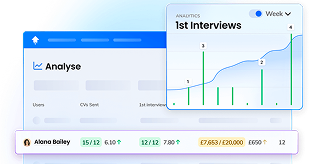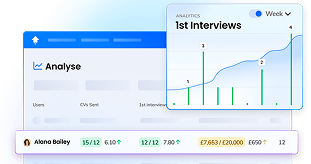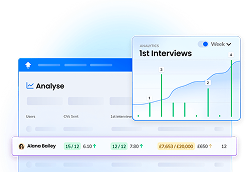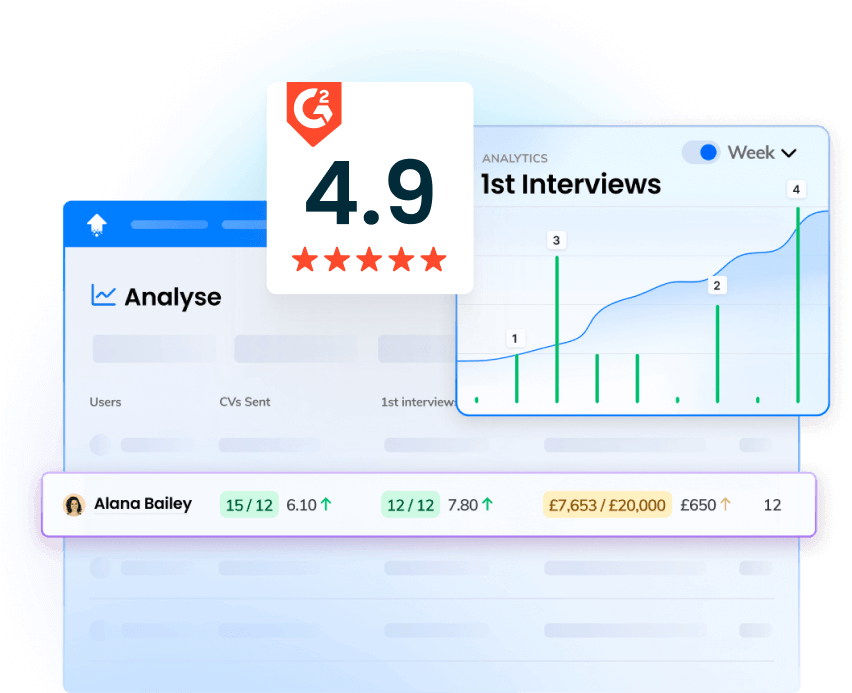Recruitment agencies must strive to optimise their hiring.
Because, as every recruiter knows, the hiring landscape is only becoming more competitive.
And those agencies with a tech stack that enables them to make strong data-driven decisions are winning.
Indeed, modern recruitment agencies are equipped with powerful analytics tools and data-driven strategies that improve accuracy, streamline processes, and enhance candidate experiences.
The results?
Happier clients, happier candidates, lower operational costs — and elevated revenue.
But agencies that fail to harness the power of data-driven recruiting — or those attempting to operate on outdated systems — face challenges around inefficiency, high costs, and biased decision-making.
This makes it incredibly difficult to deliver top results for candidates and clients, and as a result, your agency’s reputation — and revenue — can suffer.
In this guide, we’ll take you through the seven essential steps to mastering data-driven recruiting.
What is Data-Driven Recruiting?
Data-driven recruiting is the practice of using data and analytics to guide hiring decisions and optimise agency processes, enhancing the overall recruitment process.
Unlike traditional recruiting, which often relies on intuition and subjective judgments — commonly known as ‘gut instinct’ — data-driven recruiting bases decisions on measurable insights.
In data-driven hiring, recruiters track metrics surrounding key elements of the entire recruitment process, like candidate performance, sourcing effectiveness, and Time-to-Hire.
By harnessing powerful, user-friendly data analytics tools, they can determine the success of their current strategies, detect issues within their processes, and identify major trends.
The insights gleaned from this data inform recruiters how to adjust their hiring strategies and recruitment processes to achieve the best possible outcomes.
Benefits of Data-Driven Recruitment
Data-driven recruiting has a wide variety of benefits, positively impacting every single element of your hiring process.
Here are some of the key benefits you can expect to see when adopting data-driven recruitment:
#1 Better Strategic Decision-Making
Sharpen up your decision-making and strategy development with clear, informative data insights.
When you have precise data on recruiter and candidate performance, as well as recruitment market trends, you’re empowered to make informed choices, refine strategies, and adapt quickly.
For example, if your data suggests that in one month’s time there’s going to be a spike in demand for a specific type of role, you can preemptively source, vet, and qualify candidates for this position.
When demand increases, you’ll have a qualified talent pool ready to go, enabling you to place more candidates than your rivals and impress your clients.
Alternatively, say your data shows you that one of your recruiters has a significantly lower Time-to-Hire percentage than the rest of the team.
Assign them to projects with tight timeframes, and ask them to mentor colleagues with the longest Time-to-Hire.
Data also shows you where blockages and bottlenecks occur in your hiring processes, allowing you to troubleshoot in order to get things running smoothly.
This ensures smarter hiring decisions and more effective recruitment planning.
And, ultimately, means you should achieve your revenue goals more easily.
#2 Improved Hiring Accuracy
Using specific and standardised metrics to evaluate candidates means you’re significantly more likely to end up with the best match for the role.
Data from screening and assessment tools, for example, provides a strong indication of which candidates will genuinely thrive in post.
This means recruiters and hiring managers no longer need to rely solely on CVs and interviews and can instead make more informed decisions.
What’s more, by analysing data on past hires, performance, and sourcing channels, you can identify the traits of your most successful candidates and strategies.
This gives you a much more accurate picture of the type of candidate you’re looking for right from the start.
#3 Reduced Bias
Adopting a data-driven recruiting strategy reduces bias by relying on objective metrics.
By focusing on data such as candidate performance and qualifications, you can ensure a fairer evaluation process that doesn’t leave room for bias.
This helps create a more inclusive and equitable hiring practice and ensures you’re truly hiring the best candidate for the job.
#4 Enhanced Candidate Experience
In 2024, candidates expect a personalised experience.
And by analysing candidate data, you can tailor interactions to individuals, cater to personal preferences, and provide timely updates.
This thoughtful approach creates a more engaging and responsive experience, making candidates feel valued and improving overall satisfaction throughout the hiring process.
#5 Increased Efficiency and Lower Time-to-Hire
A data-driven recruitment strategy speeds up hiring and boosts efficiency by streamlining processes and focusing on the most effective sourcing channels.
This ability to swiftly spot bottlenecks and optimise workflows cuts down Time-to-Hire and makes the entire data-driven recruitment process faster and more efficient.
7 Essential Steps to Implement Data-Driven Recruiting
The benefits of data-driven recruitment are clear.
So, are you ready to embrace a smarter way of hiring?
Here’s how — in seven straightforward steps.
Step 1: Define Clear Recruitment Goals
When working with data analytics, goal-setting should always be your first port of call.
It’s crucial that the goals you set align with your agency’s overarching business objectives and roadmap.
These goals should be SMART, meaning:
- Specific
- Measurable
- Achievable
- Relevant
- Time-bound
Here’s an example of a goal that is not SMART:
“Send more CVs to clients.”
The SMART version of this goal could look something like this:
“Send at least [X number] of CVs to each client within [Y timeframe] of each job being added.”
This goal is specific, measurable, relevant, and time-bound.
To ensure it is also achievable, it’s vital to benchmark your goals against both internal data and external benchmark recruitment data.
Step 2: Collect and Centralise Recruitment Data
Next, you must gather relevant data from various sources and centralise it for easy access.
If you’ve never taken a data-driven approach to recruitment before, your data may be a bit messy.
Bits and pieces of essential data might be recorded across old or defunct software; you may have historical data in physical formats and drawers of old candidate feedback forms.
So, before centralising your recruitment data, perform a data audit.
Start by assessing your current data sources and quality.
Identify gaps, duplications, and inconsistencies, then clean and standardise the data.
Evaluate how this data will be used in decision-making and ensure compliance with regulations.
Once you’re happy with your data, it’s time to choose a data analytics platform to act as your single source of truth, and then input your existing data onto this platform.
This sounds time-consuming, but in 2024, much of the data-inputting process can be automated.
Step 3: Leverage Advanced Analytics Tools
Now that your historic data is accounted for, it’s time to set up a system to ensure robust data practices and valuable insights going forward.
First, integrate your data analytics platform (your single source of truth) with the tools across your tech stack.
Now, set up an automated process that pulls real-time data from all your software into the relevant dashboards on your data analytics platform.

OneUp, for example, automatically pulls real-time data into its custom dashboards and reports, bringing data from all your systems together in one place.
Moreover, this recruitment analytics software is super user-friendly and displays data via beautiful, intuitive visualisations that are easy to interpret.
You can build custom dashboards for teams, individuals, and managers to effectively track individual and team metrics and drill down into your analytics to see which activities contributed to which results.

Step 4: Implement and Monitor KPIs
To track progress toward your goals, you’ll need to identify and monitor key performance indicators (KPIs).
The KPIs you choose to track will vary depending on your specific goals, but some critical metrics like Time-to-Hire are important for every agency to monitor.
Popular recruitment KPIs include:
- Time-to-Hire: The average time taken from job posting to hiring
- Cost-per-Hire: Total recruitment costs divided by the number of hires
- Source of Hire: Effectiveness of different recruitment channels
- Offer Acceptance Rate: Percentage of job offers accepted by candidates
- Applicant Conversion Rate: Ratio of applicants who progress through the hiring stages
- Diversity Hiring Metrics: Measures of diversity among candidates and hires
- Recruitment Funnel Metrics: Data on each stage of the recruitment process
- Time-to-Fill: The total time to fill a position from the job requisition
Read More: How to Set Up Recruitment Analytics
Step 5: Develop Data-Driven Recruitment Strategies
To develop your data-driven recruitment strategies, start by analysing your current performance via the metrics listed above.
This data will give you important insights into trends and areas for improvement.
For example, you might notice that your offer acceptance rate has dropped significantly over the past year or that your candidate satisfaction is rocketing.
Once you’re aware of these trends, it’s easy to dig down into the data to understand the whys and glean valuable learnings.
If your acceptance rate has dipped, for example, perhaps you’ve been using a new job description writing tool that is misrepresenting the reality of roles, or maybe you stopped using a personality assessment that helped you identify the best cultural fits.
Meanwhile, if your candidate satisfaction is up, maybe you have a new recruiter on your team with outstanding people skills, or you’ve done some great work on your application forms’ UX.
Once you’ve gathered your first set of insights by tracking recruitment metrics, tailor your strategies to address any issues and boost performance.
For instance, in the first scenario, you now have the information you need to fix the issue, and in the second, you can take these learnings and improve candidate satisfaction even further!
Step 6: Optimise Recruitment Processes Continuously
Of course, the work doesn’t stop there.
Recruitment is ever-evolving, from market conditions and game-changing new tech to client needs and candidate demands.
And therefore, the data is constantly changing.
This is why it’s vital to continuously monitor your results to gain further insights, stay ahead of the curve, and continuously improve your strategies and processes.
Step 7: Train Your Team on Data Literacy
All team members must be on board if your agency is to truly benefit from a data-driven approach to recruitment.
But your recruiters won’t engage with data if they don’t know how to interpret it or use data analytics tools.
This is where data literacy training comes in.
Whether you choose to bring in an external trainer or train your team on how to use data analytics tools yourself, it’s vital to ensure that every recruiter is confident about understanding and using data.
Data-Driven Recruiting Tools and Technologies
Of course, if data is going to work for your agency, you also need to install a solid framework.
This means building a robust, user-friendly tech stack with strong integrations and advanced analytics tools.
Here are some of the crucial software to include in your recruitment agency tech stack:
- Recruitment CRM Systems: Manage candidate relationships and track interactions to enhance engagement and retention.
- ATS (Applicant Tracking Systems): Streamline application processes and gather valuable data on candidate sources and conversion rates.
- RMS (Recruitment Management Systems): Oversee the entire recruitment lifecycle, from job posting to onboarding.
- Screening and Assessment Tools: Evaluate candidate skills and fit using standardised tests and assessments and collect comprehensive data on each candidate’s skills, capabilities, and personality.
- Recruiting Analytics Software: Analyse metrics to refine strategies and make data-driven decisions in recruiting.
As outlined above, with so many systems incorporating data analytics, it’s vital to decide on a single source of truth for your data.
OneUp integrates with a wide variety of tools, such as CRMs, to pull data from across your tech stack into your OneUp dashboards in real-time.

It acts as a single source of truth, displaying real-time recruitment data on custom dashboards, leaderboards, and within automated reports.
Conclusion
Adopting a data-driven approach in recruitment is crucial for making informed, unbiased decisions and optimising your hiring processes.
It enhances efficiency, improves the quality of hires, and optimises recruitment strategies.
By leveraging data, organisations can better understand candidate behaviour, reduce hiring costs, and ultimately build stronger, more effective teams, driving long-term success.
Simply put, recruitment agencies with strong data-driven recruiting strategies are setting themselves up for success.
And those who continue to rely on gut instinct and guesswork will struggle to compete.
Ready to truly embrace data-driven recruitment?
Remember to:
- Define clear recruitment goals
- Collect and centralise recruitment data
- Leverage advanced recruitment analytics tools
- Develop data-driven recruitment strategies
- Implement and monitor KPIs
- Optimise recruitment processes continuously
- Train your team on data literacy
OneUp empowers recruitment agencies to embrace data-driven hiring by providing advanced analytics tools that track progress towards recruitment goals.
With OneUp, agencies can set up user-friendly custom dashboards to analyse recruiter performance, use data to motivate team members, and harness the power of automation to save time on data analytics.
Ready to embrace smarter recruitment? Book a OneUp demo today and see firsthand how our data-driven tools can optimise your hiring strategy.




















